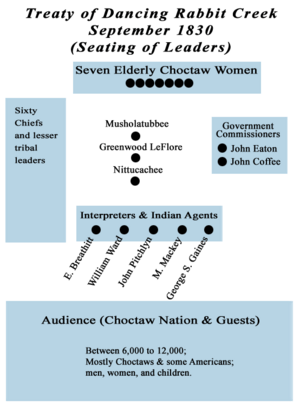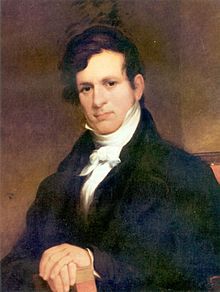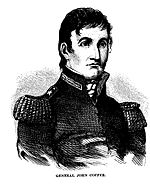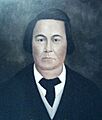Treaty of Dancing Rabbit Creek facts for kids
Quick facts for kids 
The approximate area that the treaty defined shaded in blue in relation to the future U.S. state of Mississippi
|
|
| Signed | 27 September 1830 |
|---|---|
| Location | Dancing Rabbit Creek |
| Effective | 24 February 1831 |
| Parties | |
| Citations | 7 Stat. 333 |
The Treaty of Dancing Rabbit Creek was an important agreement signed on September 27, 1830. It was made between the Choctaw Native American tribe and the United States government. This treaty was the first one put into action under the Indian Removal Act. This act aimed to move Native American tribes from their lands.
Through this treaty, the Choctaw tribe gave up about 11 million acres (45,000 km2) of their land in what is now Mississippi. In return, they received about 15 million acres (61,000 km2) in the Indian Territory. This area is now the state of Oklahoma.
Key Choctaw leaders who helped negotiate the treaty were Chief Greenwood LeFlore, Mushulatubbee, and Nittucachee. The U.S. negotiators were Colonel John Coffee and Secretary of War John Eaton.
The treaty was signed at a place the Choctaw called Bok Chukfi Ahilha, or Dancing Rabbit Creek. This spot is in the southwest part of Noxubee County. The Treaty of Dancing Rabbit Creek was the last big land agreement signed by the Choctaw. It was approved by the U.S. Congress in 1831. It also allowed some Choctaw people who stayed in Mississippi to become U.S. citizens. They were the first large non-European group to gain this recognition.
Contents
Understanding the Treaty
On August 25, 1830, the Choctaw were supposed to meet with President Andrew Jackson in Franklin, Tennessee. However, Greenwood Leflore told the Secretary of War, John H. Eaton, that the chiefs did not want to go. President Jackson was not happy about this.
Even so, Jackson felt there was still a chance for an agreement. He sent Secretary of War Eaton and General John Coffee to meet with the Choctaws in their own nation. They were to meet at the place where "rabbits gather to dance."
The U.S. officials met with the Choctaw chiefs and leaders on September 15, 1830. About 6,000 Choctaw men, women, and children were there. The U.S. officials explained the idea of moving the Choctaw people. They used interpreters to share their message.
The Choctaws had two main choices. They could move west of the Mississippi River. Or, they could stay and follow U.S. and state laws as citizens. The treaty meant giving up their traditional homeland. However, one part of the treaty made the move seem a bit more fair.
This treaty was one of the largest land deals ever made between the U.S. government and Native Americans during peacetime. The Choctaw gave up their remaining traditional lands to the United States. Article 14 of the treaty allowed some Choctaw people to stay in Mississippi. They could become citizens if they wished.
The treaty stated:
ART. XIV. Each Choctaw head of a family being desirous to remain and become a citizen of the States, shall be permitted to do so, by signifying his intention to the Agent within six months from the ratification of this Treaty, and he or she shall thereupon be entitled to a reservation of one section of six hundred and forty acres of land, to be bounded by sectional lines of survey; in like manner shall be entitled to one half that quantity for each unmarried child which is living with him over ten years of age; and a quarter section to such child as may be under 10 years of age, to adjoin the location of the parent. If they reside upon said lands intending to become citizens of the States for five years after the ratification of this Treaty, in that case a grant in fee simple shall issue; said reservation shall include the present improvement of the head of the family, or a portion of it. Persons who claim under this article shall not lose the privilege of a Choctaw citizen, but if they ever remove are not to be entitled to any portion of the Choctaw annuity.
The Choctaw were the first of the "Five Civilized Tribes" to be moved from the southeastern United States. The government wanted Native American lands for a growing American farming society. Nearly 15,000 Choctaws, along with 1,000 enslaved people, moved to what was called Indian Territory. This area later became Oklahoma.
This large move happened in three stages between 1831 and 1833. It included a harsh winter blizzard in 1830–31 and a cholera sickness in 1832. About 2,500 people died during this journey, known as the Trail of Tears. Around 5,000–6,000 Choctaws stayed in Mississippi after the first moves. For the next ten years, those who stayed faced many problems.
The Choctaw who moved, like the Creek, Cherokee, Chickasaw, and Seminole tribes who followed them, tried to rebuild their way of life in their new home.
At this time, the Choctaw became two separate groups. There was the Nation in Oklahoma and the Tribe in Mississippi. The Nation kept its right to govern itself. But the Tribe in Mississippi had to follow state and U.S. laws. Under Article XIV, the Mississippi Choctaws became one of the first major non-European groups to gain U.S. citizenship.
Key Points of the Treaty
The treaty started by saying it was for "perpetual, friendship, cession and limits." This means it was meant to create lasting peace, give up land, and set borders. It was agreed upon by U.S. representatives John H. Eaton and John Coffee, and the leaders of the Choctaw Nation.
Here are some of the main points of the treaty:
- It promised lasting peace and friendship between the two groups.
- Lands west of the Mississippi River (in what is now Oklahoma) were given to the Choctaw Nation.
- Lands east of the Mississippi River were given up by the Choctaw. The move was planned to start in 1831 and finish by 1833.
- The Choctaw Nation in Oklahoma would be free from U.S. state and territory laws forever.
- The U.S. would protect the Choctaw Nation.
- Choctaw people who committed violent acts against U.S. citizens would be handed over to U.S. authorities.
- Problems against Choctaws by U.S. citizens would be looked into fairly.
- The Choctaw Nation would not hide people running from U.S. law.
- People ordered to leave the Choctaw Nation would do so.
- Traders needed a written permit to work in the Choctaw Nation.
- Rivers that ships could use would be free for Choctaws. U.S. post offices and military posts could be set up in the Choctaw Nation.
- People who did not belong in the Choctaw Nation would be removed. If U.S. citizens stole Choctaw property, it would be returned, and the thief punished. Choctaw people who broke U.S. laws would get a fair trial.
- A U.S. agent would be appointed to the Choctaws every four years.
- Choctaws could become U.S. citizens and receive 640 acres (2.6 km2) of land in Mississippi. They would get more land for their children.
- Land was given to the Choctaw chiefs Greenwood LeFlore, Musholatubbee, and Nittucachee. They also received yearly payments.
- The U.S. would pay for wagons and steamboats for the move. They would also provide food during the move and for 12 months after the Choctaw reached their new homes. Money would be given for cattle left behind in Mississippi.
- Yearly payments from other treaties would continue. Extra payments would be made after the move.
- The Choctaw Country would be measured and mapped.
- Land was given to several other individuals.
- The U.S. would help improve the Choctaw's lives through education. They would also provide tools, weapons, and steel.
- Choctaw warriors who fought with U.S. General Wayne during the American Revolution and Northwest Indian War would receive a yearly payment.
- The Choctaw would have a delegate (a representative) in the U.S. House of Representatives.
Unapproved Section
One part of the treaty was not approved by the U.S. government. This section talked about Mississippi extending its laws over Choctaw lands. It also mentioned the President saying he could not protect the Choctaw from these laws. This part was meant to explain why the Choctaw decided to sell their lands.
Who Signed the Treaty
The main people who signed the treaty were John Eaton, John Coffee, Greenwood Leflore, Musholatubbee, and Nittucachee. Almost 200 other people also signed the treaty.
What Happened Next
After giving up about 11 million acres (45,000 km2) of land, the Choctaw moved in three main groups. The first group left in the fall of 1831, the second in 1832, and the last in 1833. The U.S. Senate approved the Treaty of Dancing Rabbit Creek on February 25, 1831. The President wanted this move to be an example for other tribes.
Before the moves began, Chief George W. Harkins wrote a letter to the American people. He explained his feelings about the move:
It is with considerable diffidence that I attempt to address the American people, knowing and feeling sensibly my incompetency; and believing that your highly and well improved minds would not be well entertained by the address of a Choctaw. But having determined to emigrate west of the Mississippi river this fall, I have thought proper in bidding you farewell to make a few remarks expressive of my views, and the feelings that actuate me on the subject of our removal.... We as Choctaws rather chose to suffer and be free, than live under the degrading influence of laws, which our voice could not be heard in their formation.... Much as the state of Mississippi has wronged us, I cannot find in my heart any other sentiment than an ardent wish for her prosperity and happiness.
—-George W. Harkins, George W. Harkins to the American People
Around 15,000 Choctaw people left their old lands for the Indian Territory. This area is now a large part of Oklahoma. Many people mistakenly think that "Oklahoma" means "red people" in the Choctaw language. However, the Choctaw words "okla" and "humma" together actually mean "an honorable Nation."
Later estimates from the late 1900s suggest that between 5,000 and 6,000 Choctaws stayed in Mississippi in 1831. For the next ten years, they faced many legal problems and unfair treatment. The Choctaw described their difficult situation in 1849:
we have had our habitations torn down and burned, our fences destroyed, cattle turned into our fields and we ourselves have been scourged, manacled, fettered and otherwise personally abused, until by such treatment some of our best men have died.
The forced moves continued even into the early 1900s. In 1903, three hundred Mississippi Choctaws were convinced to move to the Nation in Oklahoma. The Choctaw did not get a delegate in the U.S. House of Representatives. Greenwood LeFlore, a Choctaw leader, stayed in Mississippi. He was elected to the Mississippi House of Representatives and the Senate.
The Choctaw Nation continued to do well until Oklahoma became a state. Their government was taken apart under the Curtis Act. This happened to other Native American nations in the former Indian Territory. This was done to allow Oklahoma to become a state. Their shared lands were divided and given to individual families under the Dawes Act. This was meant to make them more like American farmers. The U.S. government then sold any remaining shared land to American settlers.
In the 1900s, the Choctaw reorganized their government. They were recognized by the U.S. government as the Choctaw Nation. The descendants of the Choctaw who stayed in Mississippi also reorganized. They became the Mississippi Band of Choctaw Indians in 1945 and gained federal recognition.
Images for kids
-
Mushulatubbee wanted to be elected to the U.S. Congress. This image is from 1834, Smithsonian American Art Museum.
-
Greenwood LeFlore was the chief who led the treaty talks. He was later removed from his position by a group of leaders.






